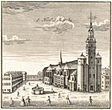Nikolaikirchhof (Leipzig)
The Nikolaikirchhof is a square in the eastern inner city of Leipzig. The Nikolaikirche stands on it . Church and square are of particular importance for the Peaceful Revolution of 1989 .
Location and development
The Nikolaikirchhof is bounded in the east by Ritterstrasse and in the west by Nikolaistrasse. That is why only properties on its north and south side have the address Nikolaikirchhof. On the north side is the renovated Alte Nikolaischule with the Antikenmuseum der Universität Leipzig, a Richard Wagner Museum about his childhood and adolescence and the "Gasthaus Alte Nikolaischule", with outdoor seating in summer. The second building on the north side is the Predigerhaus , built in 1886/1887 according to plans by Hugo Licht .
The Nikolaikirche takes up around 40% of the approximately 70 by 70 meter square. The Nikolaikirche stands on the southern half of the square, so that there is a square situation only on its north side, south only remains about the width of the street. Of the business buildings adjoining to the south, only one belongs to the Nikolaikirchhof. The rest of the property is continuous from the Grimmaische Strasse.
The view of the Nikolaikirchhof is limited to the east on Ritterstrasse by the university guest house on the site of the former bookseller exchange and the Geschwister-Scholl-Haus, and to the west on Nikolaistrasse Specks Hof and Motel One.
history
The history of the square at the church should also go back to the construction of the church, which began in the twelfth century. The construction of the Nikolaischule is documented in 1512 after a previous house was demolished. In 1573 a renaissance fountain was created at the west end of the square , which was replaced by a new one in 1657. This is no longer present in pictures from the 19th century.
Until the end of the 19th century, the north side of the square was built on with a front of three-story houses for at least 200 years. A residential and commercial building on the western corner was followed by the Nikolaischule, which was only combined with the corner building during the last renovation, which can still be seen from the window structure. Then the priest houses replaced by the preacher's house followed.
The Nikolaikirchhof acquired particular importance in connection with the events of the Peaceful Revolution of 1989 in Leipzig. In September 1989 the clashes between demonstrators and the state power came to a head following the Monday prayer for peace in the Nikolaikirche in the Nikolaikirchhof, as the Monday demonstrations were supposed to be nipped in the bud. Most of the arrests took place in the Nikolaikirchhof until the decisive demonstration on October 9th.
Monuments of the peaceful revolution
In view of its importance for the peaceful revolution of 1989, several memorials were erected on the Nikolaikirchhof.
In 1999, a 16 meter high column was erected on the east side of the square. It is a replica of the pillars within the church and symbolizes how the ideas of departure from the church were carried into public space. The palm fronds on the head of the column stand for the peacefulness of the goals. The column is part of the design with which the Leipzig artist Andreas Stötzner won an international competition for the design of the square, which was awarded by the Leipzig Cultural Foundation and the city. The column was made by the Leipzig sculptor Markus Gläser . Two thirds of the funding comes from donations from citizens, companies and institutions.
The pillar has a memorial plaque embedded in the pavement of the square, also made by glasses, with the inscription “09 OCTOBER 1989” and numerous shoe prints depicting the demonstration.
In 2003 a fountain and a light installation followed with the support of the Lebendige Stadt Foundation . The design of the fountain comes from the London architecture firm David Chipperfield . A granite bowl, 3.30 meters in diameter, filled to the brim with water in summer symbolizes the political situation in the GDR in 1989, when "every drop could make the barrel overflow".
For the light installation “Public Light” by the artists Tilo Schulz and Kim Wortelkamp, 144 light elements are embedded in the pavement of the square, which are switched on at random in the colors blue, green and magenta within three hours after dark. These points of light represent the coming together for a peaceful gathering.
literature
- Horst Riedel: Stadtlexikon Leipzig from A to Z . PRO LEIPZIG, Leipzig 2005, ISBN 3-936508-03-8 , p. 436
Web links
- The Nikolaikirchhof at Kulturstiftung Leipzig , accessed on April 1, 2014
- City of Leipzig website (fountain and light installation), accessed on April 1, 2014
- Website City of Leipzig (Nikolaisäule), accessed on April 1, 2014
- Nikolaikirchhof from Lebendige Stadt , accessed on April 1, 2014
- "Public light" at quartier vier , accessed on September 29, 2014
Individual evidence
- ↑ Official city map of Leipzig
- ↑ Stadtlexikon Leipzig from A to Z , p. 436
- ^ Angela Wandelt: Artistic Ideas Competition Nikolaikirchhof , Leipziger Blätter No. 22, 1993, p. 50/51
Coordinates: 51 ° 20 ′ 26.1 ″ N , 12 ° 22 ′ 43 ″ E









